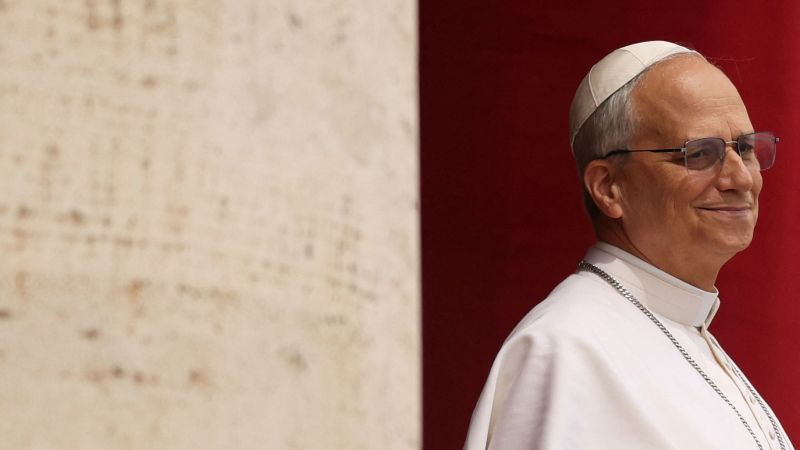Understanding Pope Leo XIII's Approach To Reform

Welcome to your ultimate source for breaking news, trending updates, and in-depth stories from around the world. Whether it's politics, technology, entertainment, sports, or lifestyle, we bring you real-time updates that keep you informed and ahead of the curve.
Our team works tirelessly to ensure you never miss a moment. From the latest developments in global events to the most talked-about topics on social media, our news platform is designed to deliver accurate and timely information, all in one place.
Stay in the know and join thousands of readers who trust us for reliable, up-to-date content. Explore our expertly curated articles and dive deeper into the stories that matter to you. Visit Best Website now and be part of the conversation. Don't miss out on the headlines that shape our world!
Table of Contents
Understanding Pope Leo XIII's Approach to Reform: A Legacy of Modernity
Pope Leo XIII (1878-1903) steered the Catholic Church through a period of immense societal upheaval, marked by industrialization, nationalism, and the rise of secularism. His papacy, far from being a bastion of resistance to modernity, witnessed a significant effort at reform and adaptation, leaving a lasting legacy on the Church's relationship with the modern world. Understanding his approach requires examining his key initiatives and the context in which they unfolded.
The Challenges Facing Leo XIII: A World in Transformation
The late 19th century presented the Catholic Church with unprecedented challenges. The rise of liberalism and socialism questioned the Church's traditional authority, while rapid industrialization created new social problems like poverty and worker exploitation. Nationalism, often at odds with the Church's universalist claims, was also on the rise. Leo XIII faced the difficult task of maintaining the Church's core doctrines while addressing these pressing social issues. This necessitated a nuanced approach that avoided both rigid conservatism and radical concessions.
Key Pillars of Leo XIII's Reform Program:
Leo XIII's response wasn't a single, sweeping reform, but a series of carefully considered initiatives. His approach can be understood through several key pillars:
-
Rerum Novarum (1891): This landmark encyclical, arguably Leo XIII's most significant contribution, addressed the social question arising from industrialization. It condemned both laissez-faire capitalism and socialist materialism, advocating for a "just wage," the right to form unions, and the importance of private property tempered by social responsibility. Rerum Novarum is considered a foundational text of Catholic social teaching and continues to influence discussions on economic justice and social ethics. You can read the full text of Rerum Novarum .
-
Engagement with Modern Philosophy: Unlike some predecessors who dismissed modern thought outright, Leo XIII encouraged engagement with contemporary philosophical currents, particularly those that emphasized the importance of reason and natural law. He promoted the study of scholastic philosophy, seeking to reconcile faith and reason in a way that could address the challenges posed by modern science and secular thought.
-
Promoting Catholic Education: Recognizing the importance of education in countering secularism and promoting Catholic values, Leo XIII emphasized the development of Catholic schools and universities. He believed that a strong Catholic education was crucial in shaping future generations and preserving the faith in a rapidly changing world.
-
Ecumenical Outreach (limited): While primarily focused on internal reform, Leo XIII did make some limited overtures towards ecumenical dialogue. His efforts, though not as extensive as those of later Popes, represented a move towards greater understanding and cooperation with other Christian denominations.
The Legacy of Leo XIII: A Balanced Approach
Leo XIII's approach to reform was characterized by a delicate balance. He defended core Catholic doctrines while acknowledging the need for adaptation to the modern world. He didn't shy away from criticizing social injustices but also cautioned against revolutionary solutions. His legacy is multifaceted and continues to be debated, but his contribution to Catholic social teaching and his attempt to reconcile faith and reason in a modern context remain significant. He laid the groundwork for a more engaged and socially conscious Church, paving the way for future Popes to grapple with the complexities of the 20th and 21st centuries.
Further Exploration:
For deeper understanding of Pope Leo XIII's pontificate and its lasting impact, further research into his other encyclicals and writings is encouraged. Exploring scholarly works on 19th-century Catholicism and the history of Catholic social teaching will provide valuable context and insights. Understanding his approach requires a careful examination of the historical context and the complexities of his efforts to navigate a world undergoing profound transformation. This nuanced understanding offers a crucial perspective on the ongoing dialogue between the Catholic Church and the modern world.

Thank you for visiting our website, your trusted source for the latest updates and in-depth coverage on Understanding Pope Leo XIII's Approach To Reform. We're committed to keeping you informed with timely and accurate information to meet your curiosity and needs.
If you have any questions, suggestions, or feedback, we'd love to hear from you. Your insights are valuable to us and help us improve to serve you better. Feel free to reach out through our contact page.
Don't forget to bookmark our website and check back regularly for the latest headlines and trending topics. See you next time, and thank you for being part of our growing community!
Featured Posts
-
 Thrilling Victory Smith Steals The Lead With A Buzzer Beater
May 13, 2025
Thrilling Victory Smith Steals The Lead With A Buzzer Beater
May 13, 2025 -
 Analyzing Ufc 315 Will Montreal Deliver A Top Tier Ppv Event In 2025
May 13, 2025
Analyzing Ufc 315 Will Montreal Deliver A Top Tier Ppv Event In 2025
May 13, 2025 -
 Analisis Tactico Alineaciones Esperadas Para Tigres Necaxa Vuelta Cuartos
May 13, 2025
Analisis Tactico Alineaciones Esperadas Para Tigres Necaxa Vuelta Cuartos
May 13, 2025 -
 26 Million Question Will Cody Bellinger Stay With Yankees
May 13, 2025
26 Million Question Will Cody Bellinger Stay With Yankees
May 13, 2025 -
 Sofia Vergaras Son Manolo Shares Unseen Photos Of Her As A Mother
May 13, 2025
Sofia Vergaras Son Manolo Shares Unseen Photos Of Her As A Mother
May 13, 2025
Latest Posts
-
 Top 7 New Movies To Stream Now September 9 15 Netflix Hbo Max And More
Sep 13, 2025
Top 7 New Movies To Stream Now September 9 15 Netflix Hbo Max And More
Sep 13, 2025 -
 Interview Unraveling The Mysteries Of Star Trek Strange New Worlds Season 3 Finale
Sep 13, 2025
Interview Unraveling The Mysteries Of Star Trek Strange New Worlds Season 3 Finale
Sep 13, 2025 -
 Brazils Bolsonaro Sentenced 27 Years For Coup Attempt
Sep 13, 2025
Brazils Bolsonaro Sentenced 27 Years For Coup Attempt
Sep 13, 2025 -
 Angels Mariners Series Potential For Upset A Detailed Look
Sep 13, 2025
Angels Mariners Series Potential For Upset A Detailed Look
Sep 13, 2025 -
 Charlie Kirks Death Examining The Circumstances Of The Shooting
Sep 13, 2025
Charlie Kirks Death Examining The Circumstances Of The Shooting
Sep 13, 2025
